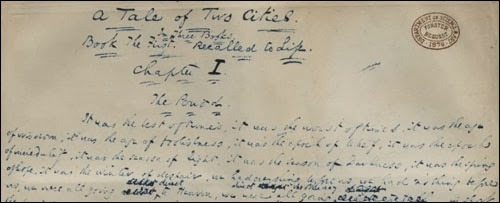Storytelling: First Paragraph
On a writing forum, writers were sharing the opening paragraph of their current project. The predominant question was whether it grabbed the reader’s attention. Most wanted an honest critique, and for the most part, people complied. A few did get snipey debating the necessity of proper grammar – whether using good grammar was a requirement for a compelling first paragraph.
What I would love to see is the various iterations of the first paragraph, from first to current draft. How did the writer change the language? How did she hone it down to gristle and bone?
One of the most famous opening paragraphs is Dickens’ A Tale of Two Cities:
“It was the best of times, it was the worst of times, it was the age of wisdom, it was the age of foolishness, it was the epoch of belief, it was the epoch of incredulity, it was the season of Light, it was the season of Darkness, it was the spring of hope, it was the winter of despair, we had everything before us, we had nothing before us, we were all going direct to heaven, we all going direct the other way – in short, the period was so far like the present period, that some of its noisiest authorities insisted on its being received, for good or for evil, in the superlative degree of comparison only.”
What did Dickens’ first draft look like? Did the language spring perfectly from his head? My guess is that he had to craft it to make it ring.
 Facsimile of the first lines of the manuscript, Victoria and Albert Museum
Facsimile of the first lines of the manuscript, Victoria and Albert Museum
Sometimes I remind myself it’s okay to have a shitty, meandering first draft (thanks, Anne Lamott). Eventually through revision I will get to the language I want.
Here’s a first-draft sample from my current project, Reston Peace. This is not the first paragraph, but the first one in the narrator’s (Kenny’s) voice:
“I could as easily start with a description of her, Eileen Hesperin, who initially interviewed me for a magazine piece about Living with AIDS. I don’t know how my name came up, out of the myriad, but I said sure, and she offered to come over on Saturday. She was an attractive woman in her late thirties, with scoops of pale brown hair nested over her ears, and a lean chiseled cut to her cheekbones. She shook hands with authority and a firm grip, and maneuvered easily along lines of professional friendliness to put me at ease, I suppose. A fierce, intelligent smile, and a strong voice that commanded attention. I met her at a coffee shop early enough in the afternoon so that we would not be distracted by customers.”
This is what it looks like now:
“I could easily start my story with a description of Eileen Hesperin, an attractive woman in her late thirties, with curly brown hair. She had a smooth, round face, and tiny pucker that hid her tiger’s smile. While her handshake was a throw-down, her professional courtesy was intended to put me at ease. I met her at a coffee shop early in the afternoon when few other customers were around.”
While the first version meanders into the story, the second version gets down to business. The purpose of the interview comes later in Eileen’s conversation, rather than in an expository line.
[As a further example of tightening language, here’s the first draft of the previous paragraph: “The second version gets down to business, while the first one meanders into the story. The purpose of the interview comes later, in the conversation, rather than in an expository line. Right now, I like the crispness of the current version, but since I’m still working on this draft, it will likely change, not radically, but hopefully in a manner that will make it crisper.”
At this rate, I could write an entire blog in which I give examples of each paragraph as I write it … ]
In my next blog, I’ll pick apart why I made the changes that I did.
What I would love to see is the various iterations of the first paragraph, from first to current draft. How did the writer change the language? How did she hone it down to gristle and bone?
One of the most famous opening paragraphs is Dickens’ A Tale of Two Cities:
“It was the best of times, it was the worst of times, it was the age of wisdom, it was the age of foolishness, it was the epoch of belief, it was the epoch of incredulity, it was the season of Light, it was the season of Darkness, it was the spring of hope, it was the winter of despair, we had everything before us, we had nothing before us, we were all going direct to heaven, we all going direct the other way – in short, the period was so far like the present period, that some of its noisiest authorities insisted on its being received, for good or for evil, in the superlative degree of comparison only.”
What did Dickens’ first draft look like? Did the language spring perfectly from his head? My guess is that he had to craft it to make it ring.
 Facsimile of the first lines of the manuscript, Victoria and Albert Museum
Facsimile of the first lines of the manuscript, Victoria and Albert MuseumSometimes I remind myself it’s okay to have a shitty, meandering first draft (thanks, Anne Lamott). Eventually through revision I will get to the language I want.
Here’s a first-draft sample from my current project, Reston Peace. This is not the first paragraph, but the first one in the narrator’s (Kenny’s) voice:
“I could as easily start with a description of her, Eileen Hesperin, who initially interviewed me for a magazine piece about Living with AIDS. I don’t know how my name came up, out of the myriad, but I said sure, and she offered to come over on Saturday. She was an attractive woman in her late thirties, with scoops of pale brown hair nested over her ears, and a lean chiseled cut to her cheekbones. She shook hands with authority and a firm grip, and maneuvered easily along lines of professional friendliness to put me at ease, I suppose. A fierce, intelligent smile, and a strong voice that commanded attention. I met her at a coffee shop early enough in the afternoon so that we would not be distracted by customers.”
This is what it looks like now:
“I could easily start my story with a description of Eileen Hesperin, an attractive woman in her late thirties, with curly brown hair. She had a smooth, round face, and tiny pucker that hid her tiger’s smile. While her handshake was a throw-down, her professional courtesy was intended to put me at ease. I met her at a coffee shop early in the afternoon when few other customers were around.”
While the first version meanders into the story, the second version gets down to business. The purpose of the interview comes later in Eileen’s conversation, rather than in an expository line.
[As a further example of tightening language, here’s the first draft of the previous paragraph: “The second version gets down to business, while the first one meanders into the story. The purpose of the interview comes later, in the conversation, rather than in an expository line. Right now, I like the crispness of the current version, but since I’m still working on this draft, it will likely change, not radically, but hopefully in a manner that will make it crisper.”
At this rate, I could write an entire blog in which I give examples of each paragraph as I write it … ]
In my next blog, I’ll pick apart why I made the changes that I did.
Published on February 23, 2014 12:16
No comments have been added yet.



